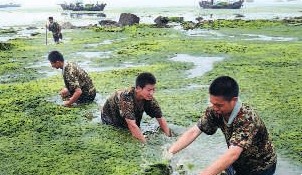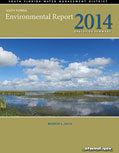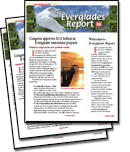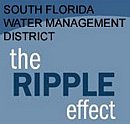| |
BOOKS and
REPORTS :



SFER Reports - from
 through
through
2010
2011
2012
2013 (Summary)
These are 
SELECTED FEATURED articles from many.
CLICK titles for ABSTRACTS
and more for
FULL TEXTS |
|
|
|
| |
|
| |
SCIENTIFIC LITERATURE presented by EvegladesHUB.com FEATURED ARTICLES |
- "Water, vegetation & sedim. gradients in submerged aqua. veget. mesocosms used for low-level P removal" - (2011)
-
DeBusk, T.A., Kharbanda, M., Jackson, S.D., Grace, K.A., Hileman, K. and Dierberg, F.E.
»
FULL TEXT
Gradients in phosphorus (P) removal and storage were investigated over 6 years using mesocosms (each consisting of three tanks in series) containing submerged aquatic vegetation (SAV) grown on muck and limerock (LR) substrates. Mean inflow total P concentrations (TP) of 32 mu g L(-1) were reduced to 15 and 17 mu g L(-1) in the muck and LR mesocosms, respectively. Mesocosm P loading rates (mean = 1.75 g m(-2) year(-1)) varied widely during the study and were not correlated with outflow TP, which instead varied seasonally with lowest monthly mean values in December and January. The mesocosms initially were stocked with Najas guadalupensis, Ceratophyllum demersum, and Chara zeylanica, but became dominated by C zeylanica. At the end of the study, highest vegetative biomass (1.1 and 1.4 kg m(-2) for muck and LR substrates) and tissue P content (1775 and 1160 mg kg(-1)) occurred in the first tank in series, and lowest biomass (1.0 and 02 kg m(-2)) and tissue P (147 and 120 mg kg(-1)) in the third tank Sediment accretion rates (2.5, 1.9 and 0.9 cm yr(-1) on muck substrates), accrued sediment TP (378, 309 and 272 mg kg(-1)), and porewater soluble reactive P (SRP) concentrations (40, 6 and 4 mu g L(-1)) in the first, second and third tanks, respectively, exhibited a similar decreasing spatial trend. Plant tissue calcium (Ca) near mesocosm inflow (19-30% dry weight) and outflow (23-26%) were not significantly different, and sediment Ca was also similar (range of 24 to 28%) among sequential tanks. Well-defined vegetation and sediment enrichment gradients developed in SAV wetlands operated under low TP conditions. While the mesocosm data did not reflect deterioration in treatment performance over 6 years, accumulation of P-enriched sediments near the inflow could eventually compromise hydraulic storage and P removal effectiveness of these shallow systems.
»
FULL TEXT pdf - -
- "Legacy and Fate of Mercury and Methylmercury in the Florida Everglades" - (2011)
-
Liu, G.L., Naja, G.M., Kalla, P., Scheidt, D., Gaiser, E. and Cai, Y. (2011) Envir.Sci.Technol. 45(2), 496-501.
»
FULL TEXT
Mass inventories of total Hg (THg) and methylmercury (MeHg) and mass budgets of Hg newly deposited during the 2005 dry and wet seasons were constructed for the Everglades. As a sink for Hg, the Everglades has accumulated 914, 1138, 4931, and 7602 kg of legacy THg in its 4 management units, namely Water Conservation Area (WCA) 1, 2, 3, and the Everglades National Park (ENP), respectively, with most Hg being stored in soil. The current annual Hg inputs account only for 1-2% of the legacy Hg. Mercury transport across management units during a season amounts to 1% or less of Hg storage, except for WCA 2 where inflow inputs can contribute 4% of total MeHg storage. Mass budget suggests distinct spatiality for cycling of seasonally deposited Hg, with significantly lower THg fluxes entering water and floc in ENP than in the WCAs. Floc in WCAs can retain a considerable fraction (around 16%) of MeHg produced from the newly deposited Hg during the wet season. This work is important for evaluating the magnitude of legacy Hg contamination and for predicting the fate of new Hg in the Everglades, and provides a methodological example for large-scale studies on Hg cycling in wetlands. »
FULL TEXT pdf - -
- "Modeling Phosphorus Dynamics in Everglades Wetlands and Stormwater Treatment Areas" - (2011)
-
Longitudinal gradients in phosphorus (P) stored in the water column, vegetation, and soils develop in the wetlands where inflow P concentrations exceed background levels. Before the mid 1990's, the Everglades regional P gradient ranged from 100-200 mg L-1 in marsh inflows to background levels of 4-8 mg L-1. Subsequent implementation of P controls, including agricultural Best Management Practices and Stormwater Treatment Areas (STAs), has reduced the average inflow concentration along the northern edge of the Water Conservations Areas to approximately 30-50 mg L-1. Additional P controls are being implemented and further measures beyond those currently planned will be required to restore the entire marsh. The authors describe the evolution and application of relatively simple mass-balance models to simulate P storage and cycling processes along P gradients in the STAs and marsh. The models are practical tools with historical and future applications to designing P control measures involving source controls, water management, reservoirs, and STAs, as well as forecasting marsh responses to implementation of those control measures.
»
FULL TEXT pdf
- "Environ .& mgmnt factors that influence drainage water P loads from Everglades Agri. Area farms of SoFL" - (2010)
-
Environmental impacts from drainage water phosphorus (P) loads from Everglades Agricultural Area (EAA) farms in South Florida led to the adoption of best management practices (BMPs). The BMPs have been very successful at reducing EAA farm drainage water P loads. However, analytical investigation into how environmental and management factors affect farm P loading may allow additional improvements in BMP performance. Sixteen variables that included cropping systems, water management, and farm specific constants were hypothesized to affect farm P loads. Data collected from ten farms between 1992 and 2002 were analyzed using Spearman correlation, Principal Component Analysis, and stepwise multivariate regression. Monthly farm P load on a unit area basis (UAL) showed stronger correlation with drainage unit area volume (UAV) than with flow weighted total P concentration (FWTP). The UAL was negatively correlated with irrigation demand and positively correlated with irrigation P concentration, rainfall, preceding month's rain, drainage pumping to rainfall ratio, and percent fallow plus flooded field acreage (PFFA). A positive correlation between soil depth and FWTP was significant Stepwise regression analysis identified canal water level management, percent sugarcane acreage, PFFA, and irrigation water P concentration as explanatory variables that impact farm P loads; PCA revealed similar results. The study suggests that lower pumping to rainfall ratio and increased sugarcane acreage lead to lower farm P loads; that irrigation water P concentration impacts farm P loads; and that shallower soils export less P than deeper soils.
» FULL TEXT pdf
- "Hydrochemical impacts of limestone mining" - (2010)
-
Naja, G.M., Rivero, R., Davis, S.E. and Van Lent, T. Water Air and Soil Pollution 217(1-4), 95-104.
»
FULL TEXT
 |
|
Hydrochemical impacts of shallow rock industrial-scale mining activities close to sensitive constructed and natural wetlands were investigated. The shallow surficial groundwater and surface water in the Everglades Agri.l Area were characterized. The chemical composition of sulfate and chloride in groundwater increased with depth. The average concentration of chloride |
averaged 182 mg/L at 6 m deep and increased gradually to 1,010 mg/L at15 m deep, 1,550 mg/L at 30 m deep to reach 7,800 mg/L at 60 m deep. Comparatively, the surface water chemical composition in the surrounding areas showed much lower cationic and anionic charge. The specific conductivity and total dissolved solids of surface water in canals (close to the mining operations) are <900 µS/cm and <600 mg/L, respectively, which should be compared to groundwater quality in wells from the EAA area (>2,000 µS/cm and >1,000 mg/L, respectively). A steady-state groundwater fluid flow and transient solute transport modeling exercise was conducted to estimate surface-ground water interactions. The modeled solute in surface water was transported downgradient through groundwaters, migrated approx. 30 m from the source area (after 5 years of operation), and needed more than 116 years to dissipate. An upward transport was also identified whereby chloride and sulfate, naturally present in deeper groundwaters, migrated approximately 200 m (after 1 year of mining) into the pristine shallower aquifer and reached the surface water with a concentration = 80% of that in the rock mining pit.
»
FULL TEXT pdf
- "Sulfur in the SoFL Ecosystem: Distribution, sources, biogeochemistry, impacts, & management for restoration" - (2010)
-
Orem, W., Gilmour, C., Axelrad, D., Krabbenhoft, D., Scheidt, D., Kalla, P., McCormick, P., Gabriel, M. and Aiken, G. Envir. Sci. Technol. Crit. Rev.
»
FULL TEXT
Mass inventories of total Hg (THg) and methylmercury (MeHg) and mass budgets of Hg newly deposited during the 2005 dry and wet seasons were constructed for the Everglades. As a sink for Hg, the Everglades has accumulated 914, 1138, 4931, and 7602 kg of legacy THg in its 4 management units, namely Water Conservation Area (WCA) 1, 2, 3, and the Everglades National Park (ENP), respectively, with most Hg being stored in soil. The current annual Hg inputs account only for 1-2% of the legacy Hg. Mercury transport across management units during a season amounts to 1% or less of Hg storage, except for WCA 2 where inflow inputs can contribute 4% of total MeHg storage. Mass budget suggests distinct spatiality for cycling of seasonally deposited Hg, with significantly lower THg fluxes entering water and floc in ENP than in the WCAs. Floc in WCAs can retain a considerable fraction (around 16%) of MeHg produced from the newly deposited Hg during the wet season. This work is important for evaluating the magnitude of legacy Hg contamination and for predicting the fate of new Hg in the Everglades, and provides a methodological example for large-scale studies on Hg cycling in wetlands.
»
FULL TEXT pdf
- NUTRIENTS'09: "Controling eutrophication: Nitrogen and Phosphorus" - (2009)
-
Conley, D.J., Paerl, HW, Howarth, RW, Boesch, DF, Seitzinger, SP, Havens, KE, Lancelot, C and Likens, GE. Science 323, 1014-15.
 |
|
Soldiers in China had to be called to remove an excessive accumulation of sea algae at the Olympic site for sailing.
Improvements in the water quality of many freshwater and most coastal marine ecosystems requires reductions in both nitrogen and phosphorus inputs. All should understand that in the Everglades we are dealing with a unique and an extremely fragile system that is difficult to tune right. » FULL TEXT |
- HYDROLOGY'09: "Groundwater's significance to changing hydrology, water chemistry, and biological communities of a floodplain ecosystem, Everglades, South Florida, USA" - (2009)
-
Mass inventories of total Hg (THg) and methylmercury (MeHg) and mass budgets of Hg newly deposited during the 2005 dry and wet seasons were constructed for the Everglades. As a sink for Hg, the Everglades has accumulated 914, 1138, 4931, and 7602 kg of legacy THg in its 4 management units, namely Water Conservation Area (WCA) 1, 2, 3, and the Everglades National Park (ENP), respectively, with most Hg being stored in soil. The current annual Hg inputs account only for 1-2% of the legacy Hg. Mercury transport across management units during a season amounts to 1% or less of Hg storage, except for WCA 2 where inflow inputs can contribute 4% of total MeHg storage. Mass budget suggests distinct spatiality for cycling of seasonally deposited Hg, with significantly lower THg fluxes entering water and floc in ENP than in the WCAs. Floc in WCAs can retain a considerable fraction (around 16%) of MeHg produced from the newly deposited Hg during the wet season. This work is important for evaluating the magnitude of legacy Hg contamination and for predicting the fate of new Hg in the Everglades, and provides a methodological example for large-scale studies on Hg cycling in wetlands.
»
FULL TEXT pdf - -
|
|
 South Florida Environmental Report
South Florida Environmental Report
(by SFWMD and FDEP)


 These are These are
SELECTED
FEATURED articles
from many.
CLICK titles for ABSTRACTS
and more for
FULL TEXTS |
|
|
|




